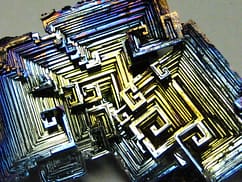This suit built in 1935 by BF Goodrich was the third such suit made for aviator Wiley Post. The first practical design, it featured an inner rubber bladder and a rubberized fabric outer layer which was glued to a frame with joints to facilitate movement. Post used his suit to fly to an altitude of 50,000 feet, where he discovered the jet stream. Post’s suit is the predecessor to all modern pressure suits, which operate on the same basic principes.
The XMC-2 suit built by the David Clark Company for the X-15 program is tested by Scott Crossfield, 1955. The suit would be worn on many early X-15 flights and later modified to create the MC-2 suit.
Crossfield in the MC-2 suit, which was used for later X-15 flights. The MC-2 suit would go on to be the basis for numerous future US spacesuits. Clearly visible here is the neck dam, required to separate the nitrogen-pressurized suit body from the oxygen in the helmet.
Joe Walker became the first human to make multiple spaceflights, taking the X-15 above 100 km on two separate occasions in 1963.
NASA chose the Navy Mk IV spacesuit, built by BF Goodrich for high-altitude fighter pilots, for Project Mercury in part due to its small size, a necessity in the cramped Mercury capsule. Here Alan Shepard wears his Mk IV suit shortly before becoming the first American in space.
For Project Gemini, NASA again turned to the David Clark Company to build a series of spacesuits. Here Neil Armstrong wears the G2-C, which was used for early training and testing.
The first Gemini crew, Gus Grissom and John Young, wore the G3-C suit. After their flight, it was replaced with the G4-C to facilitate extravehicular activities.
The G4-C suit came in an IVA and EVA variant and was worn on all subsequent Gemini flights (except Gemini VII).
Ed White made the first US spacewalk in the G4-C spacesuit, connected to the capsule by an umbilical.
The G4-C was modified slightly for Gemini IX in order to test the USAF Astronaut Maneuvering Unit. Additional layers and an outer Chromel R cover protected the astronaut from hot gases expelled from the AMU.
For the 14-day Gemini VII flight, the G5-C suit was designed to be removed during the mission. A zippered hood with a faceplate instead of a helmet and additional adjustment zippers facilitated in-flight removal of the suit.
With the conclusion of Project Gemini and the beginning of Apollo, NASA elected to use a modified G3-C suit on early Block I flights. With a design competition for a lunar EVA suit underway, NASA modified the G3-C to create the A1C IVA suit, seen here worn by the Apollo 1 crew.
After the Apollo 1 fire, NASA cancelled all manned Block I flights and use of the A1C suit ended. The replacement Block II suit was the A7L, built by ILC Dover. Seen here is the inner suit without the Integrated Thermal and Micrometeoroid Garment (ITMG) worn to protect the astronaut from thermal radiation and punctures.
Apollo 15, 16, and 17 planned longer-duration EVAs facilitated by the Lunar Roving Vehicle. To accommodate, the A7L was modified to create the A7LB, which featured new joints at the waist and neck, as well as rearranged hose connectors to allow astronauts to comfortably sit in and drive the LRV. Additionally, the inner neck ring housed pouches for energy bars to be eaten during long EVAs.
Skylab astronauts wore further modified A7LB suits with a simplified ITMG and visor. Because Skylab EVAs were typical short in duration, life support was provided via an umbilical, with an emergency oxygen supply carried on the astronaut’s right thigh.
For the Apollo-Soyuz Test Project, astronauts wore A7LB suits with unused hose connections removed and a simplified cover layer. Since no EVA was planned, no EVA helmets or gloves were carried onboard.
The Shuttle Ejection Escape Suit was worn from STS-1 to STS-4, after which the Shuttle was declared operational and ejection seats were removed. Based on the suits worn by SR-71 pilots, the SEES allowed for ejections up to Mach 2.7 and 80,000 ft.
After STS-4 and before the Challenger disaster, Shuttle crews wore no pressure suits. Starting with STS-26, crews wore the Launch Entry Suit, which was a partial pressure suit built by the David Clark Company.
Due to the limitations of the partial pressure LES, the Advanced Crew Escape Suit was introduced after STS-65. This full pressure suit was a direct descendant of the MC-2 and Gemini spacesuits.
The Extravehicular Mobility Unit, designed to perform EVAs from the Shuttle, was first introduced in 1981. It features a hard upper torso and soft lower torso and arms.
When use of the EMU was extended to the ISS, an enhanced version was developed which features a modular design that can be adjusted to fit multiple crew members on-orbit. Additionally, the Simplified Aid for EVA Rescue (SAFER) propulsion pack was added to allow an untethered astronaut to return to the ISS.

SAFER pack
The Z-1 prototype suit was built by ILC Dover for NASA and features primarily soft components with a suitport entry interface.
NASA awarded ILC $4.4 million to develop the Z-2 prototype, which will feature a hard upper torso to improve durability and will be tested in the Neutral Buoyancy Lab.
source:imgur.com













































![Private Study Rooms of Famous People [27 Pics] walther-rathenau](https://ml9uaatpjjgr.i.optimole.com/cb:gnKS.29607/w:269/h:182/q:mauto/https://alterminds.xyz/wp-content/uploads/2015/04/walther-rathenau.jpg)
